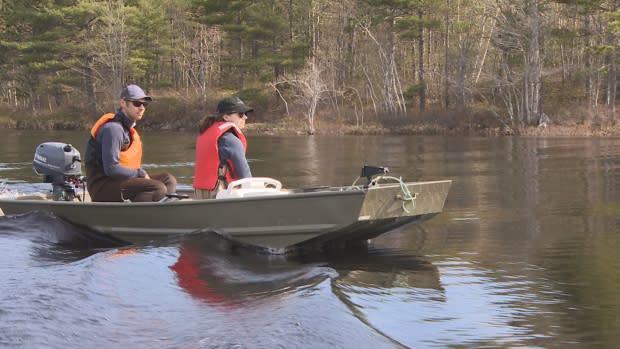'Fluke' sighting of endangered Atlantic whitefish brings hope for survival
There was an encouraging sign this week for a critically endangered Canadian fish teetering on the brink of extinction in the wild.
Six adult Atlantic whitefish were observed in an isolated Nova Scotia lake for the first time in six years.
"There are probably fewer than a couple hundred individuals in the wild, so seeing them is rare and encountering any of them is significant," says federal fisheries scientist Jeremy Broome.
An ancient relative of salmon, the remaining Atlantic whitefish population survives in just three lakes outside Bridgewater.
The discoveries were made over two nights in the largest of the lakes, Minamkeak, by members of Coastal Action, an environmental group that is part of a federal recovery project.

The team was electrofishing to remove invasive predators species — smallmouth bass and chain pickerel — that threaten the whitefish.
A device in the water emits electric current that stuns passing fish and three whitefish were inadvertently stunned and picked up.
"As soon as the whitefish were identified, electrofishing ended at the site. It is sometimes hard to identify the fish prior to dipping them from the water, but once they were captured they were immediately identified," says project co-ordinator Shawn Feener.
The fish were quickly released after it was determined they were unharmed, says Broome.
"We were not anticipating seeing these fish, so this was a fluke," he says.
In addition to the whitefish that were accidently stunned, the team saw three more adults swimming behind the boat at the edge of the electric field.
Hope for more genetic variability
Minamkeak is part of the three lake Petite Rivière watershed that supplies drinking water to Bridgewater.
Dams and other structures between the lakes have somewhat isolated them from each other.
An adult was caught in a floating trap in 2018 at neighbouring Milipsigate Lake, where dozens of juveniles have been captured and taken to a captive breeding program underway at Dalhousie University.
While no adults have been seen in Minamkeak since 2014, several juvenile whitefish have been trapped downstream.
"Observing adults has confirmed that spawning is occurring there. We have this other sort of isolated population that we've confirmed. There's potential for genetic variability that we're not seeing being represented in the Milipsigate population," says Broome.
So far evidence of 13 mothers
Since 2018, all juveniles captured at various outfalls in the lake system have been whisked away to the Aquatron Laboratory, a leading aquatic research facility at Dalhousie and now a Noah's Ark for whitefish.
Genetic testing of the collected fish has tracked their parentage to just 13 different mothers, says Broome.
Those juveniles are now old enough to begin spawning, which is expected to start this winter.
In the meantime the Department of Fisheries and Oceans continues to look for a suitable Nova Scotia location to establish a new population.
They're looking for a watershed free of invasive species with habitat that will allow them to survive warm temperatures and lower oxygen levels in summer and offer a place to spawn.
"We're going out and collecting some baseline scientific data from these systems and collectively that information will come back to a body of people that will be involved in making a decision on what would be the best location to pursue," says Broome.
Shawn Feener, at Coastal Action, was excited by the rare encounter.
"Very happy they were healthy adults and were released unharmed. It makes me feel hopeful for the future having seen healthy adults."
MORE TOP STORIES

